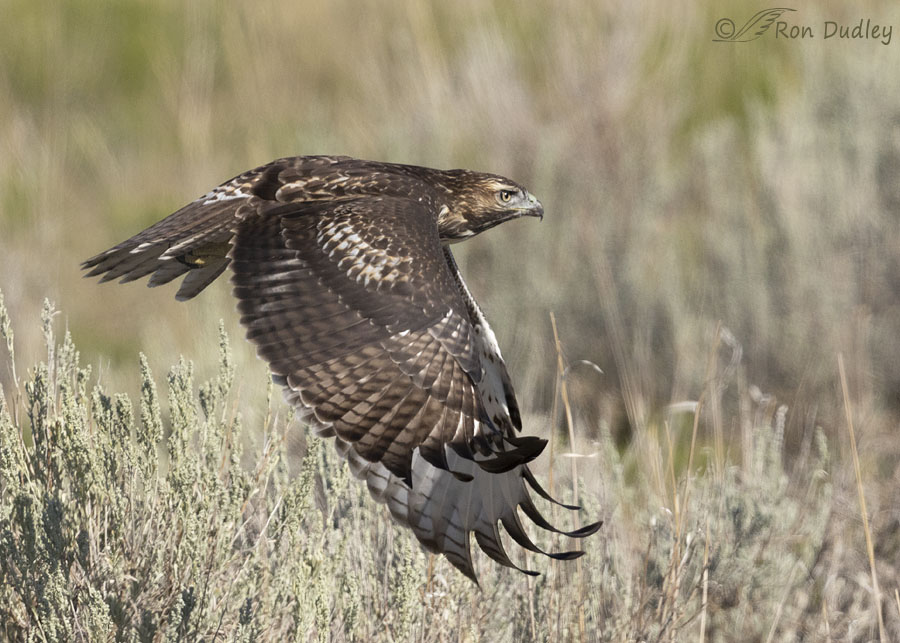More curled primaries.
Three weeks ago I posted a photo of a juvenile Red-tailed Hawk in flight whose primaries on both wings were curled by air pressure caused by strenuous flight. At the time I mentioned how much I like seeing curled primaries in my photos, as evidence of how well they’re ‘engineered’ to get the job done without breaking under that much physical pressure.
Yesterday I found another photo of the same hawk that illustrates the same feature.

1/8000, f/6.3, ISO 800, Canon R5, Canon EF500mm f/4L IS II USM + 1.4 tc, not baited, set up or called in
It was taken quite a while after ‘he’ took off but he was on a mission, presumably after prey, so he was still attempting to gain speed which resulted in dramatically curled primaries on both wings. I’m always amazed that such light and supposedly ‘delicate’ structures as feathers can withstand that much bending without breaking or being damaged in some other way.
I like the photo for other reasons too, including his concentration and sense of purpose and his flared and ‘scooped’ tail. He’s sharp, I like the sagebrush-dominated setting and background and the feather groups on his right wing are unusually well defined.
If you’re thinking I’ve been posting a lot of Red-tailed Hawk photos lately, you’re right. Which brings to mind an old friend, an excellent bird photographer and a good guy, who famously said years ago that he doesn’t photograph red-tails because they’re so “common” in his area. Well, guess what he posted to social media yesterday. Yup, a photo of a Red-tailed Hawk.
A love, or at least an appreciation, for red-tails is contagious – eventually they’ll get ya.
Ron
PS – Apparently some readers are having troubles with my blog this morning. Some can’t load it and others can’t comment. I’m looking into it but so far I’m stumped.


This is a late-to-the-party post, but I wanted to comment on the other photographer’s finally posting a Red-tail photo. Nowadays, I advise people to never take the sight of any species for granted. I remind them that the Passenger Pigeon flocks once darkened the skies for miles. I also encourage them to take a closer look at behavior and interactions with other species.
One reason that I strongly encourage people to follow your blog is that you really “see” the birds, whether it’s plumage, behavior, etc. I love seeing the feather flex.
I could not type directly into the comment section.
I had to type in Notes, copy, & paste.
Gorgeous Hawk!
Your post didn’t appear till late here – which is fine because after nearly 22 hours in a row without sleep I didn’t get up until nearly six this morning.
Feathers are masterly engineering aren’t they? And beautiful too.
Geez, I wish I knew what was going on, EC. I hope you get a couple of naps today.
Domestic duties teemed with my usual voluntary work. I will be busy today and tomorrow too but hope to make time for naps. Long naps.
When I like something, a song, a recipe, an author, I tend to stick with it or them. So it is with your Red-tailed Hawks. Always something new to see and learn.
That’s another way we’re alike. Thanks, Lyle.
Gorgeous is right on. Another beautiful Red-tail. He really looks locked onto whatever prey awaits his arrival. Hope you gave your friend a little jab regarding his posting.
Thanks, Everett. Nah, I wouldn’t tease him about it. I applaud him for it.
Beautiful!
Charlotte Norton
Thanks, Charlotte.
And today’s anatomy lesson is “The Bird Wing”. A perfect example of all the layers, all the kinds of feathers, and countable, no less! And with curls to make you smile.
Red sun shining thru the smoke here in Central WA, visible black soot in the bird water dish. Another day of “unhealthy” air.
Thanks, Carolyn. Our so-called ‘storm’ has cleared the air of smoke but so far the rain that was forecast hasn’t made an appearance.
Beautiful bird. Beautiful photo.
Thank you, Michael.
It IS a gorgeous hawk! 🙂 The amount of flex those feathers will take without breaking always impresses me. The detail in this shot is great as it his intensity of purpose.
Smoke awful yesterday – bit of a break today and cooler…..
Thanks, Judy. We were supposed to have rain by now. None yet to speak of.